

Active deforestation has begun in several Moscow districts since the start of the new year. As The Insider found out, sites are being cleared to accommodate the Defense Ministry's requirements, specifically for air defense installations. Losiny Ostrov and Timiryazev Agricultural Academy's experimental fields have already seen the deployment of S-400 anti-aircraft missile systems. In the Pechatniki district, approximately 100 hectares of forest in the Kolomenskoye Museum Reserve's protective zone have been cleared, raising concerns among locals that the Church of the Ascension, a UNESCO World Heritage site, may be at risk. Military experts caution that constructing military facilities near tall buildings endangers residents. The Insider has visited the construction sites to examine Moscow's defense preparations.
Content
Military equipment in the Timiryazev Academy's experimental fields
Air defense in the Losiny Ostrov park
Military-environmental disaster in Kuryanovo
Kolomenskoye without UNESCO
Destruction of larches in Izmailovsky Park
Air defense on a garbage heap in New Moscow
Pantsir-S1 in central Moscow
There is not enough air defense systems to protect all of Moscow
Military equipment in the Timiryazev Academy's experimental fields
“It's for the protection of Moscow,” a patrol officer explains, casting a glance in the direction of the experimental fields of the Timiryazev Moscow Agricultural Academy. A site in the Timiryazev district of northern Moscow was the first location within city limits to witness the installation of air defense systems. The tops of S-400 surface-to-air missile launchers are clearly visible from Valaam Street.
The S-400 is a long- and medium-range anti-aircraft missile system, with four launchers positioned for operation on the test fields. A 92H6E multifunctional radar has also been deployed on-site to detect and track air targets. Initially, the radar was installed on a wheeled chassis, but at the end of February, it was moved to a 40B6M mobile tower with a height of approximately 25 meters. Additionally, the site features the 96L6E all-height radar situated in the center, designed to determine the coordinates of aerial targets such as planes, helicopters, UAVs, and missiles. Fuel tanks are located between the two towers.
The process of equipping the experimental fields began on December 31st, but at the time, no pertinent information was available on any of the government portals, nor was there a mandatory information board for the construction. Inquiries from local residents also went unanswered. Remarkably, the site was prepared in under two weeks, and as there was no dense forest on the experimental fields, the soil was simply flattened and covered with asphalt.
The equipment site is encircled by two fences; the original one was erected around the experimental fields, while the second, more robust fence, was installed directly around the military facility. Four observation posts line the perimeter, and although taking photographs is prohibited by the police, there is no attempt to conceal the nature of the operation: “If they put it up, it means it is necessary. Let it be here given the current situation! Is it real? Well, I think they will use it if they need to”.
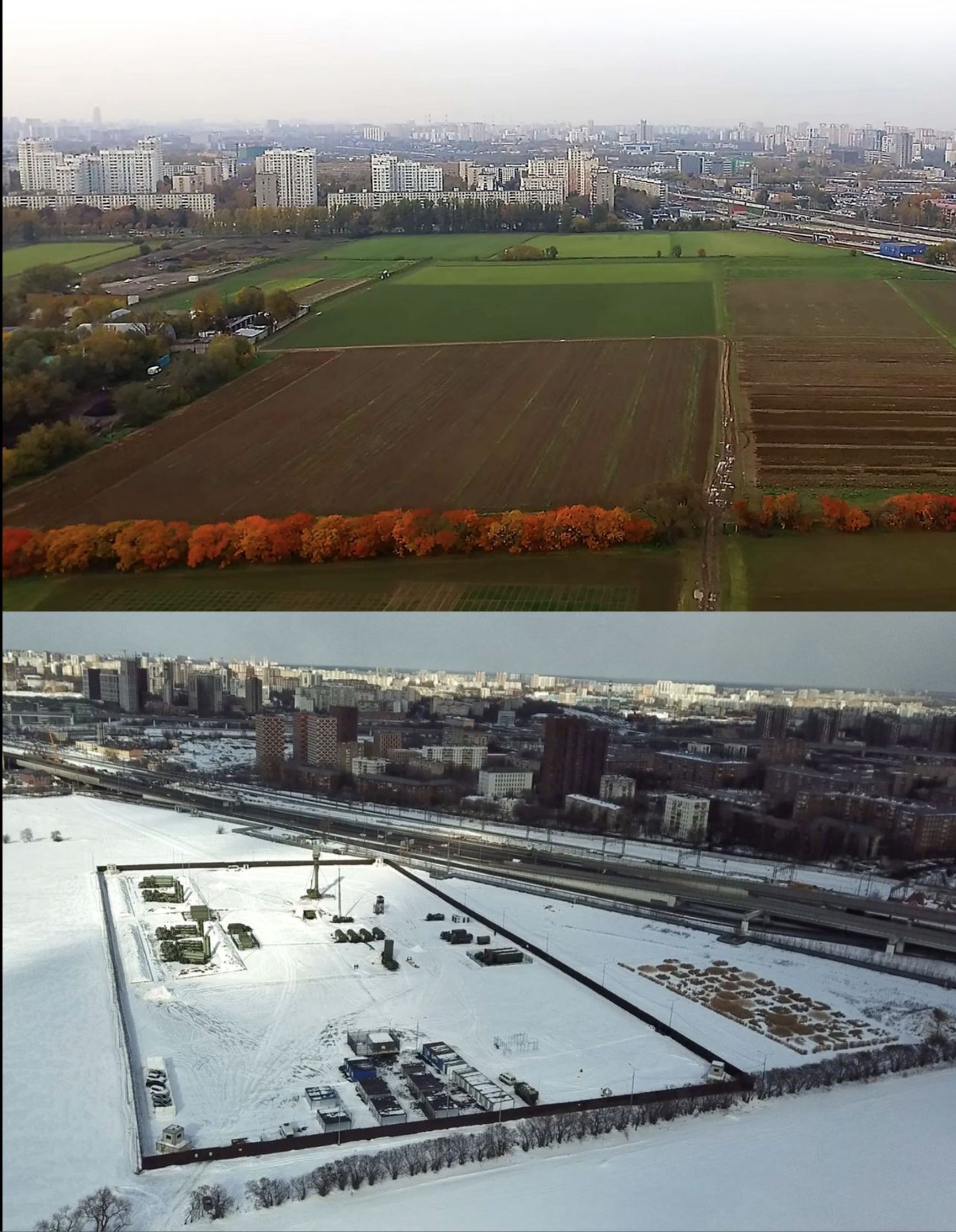
Residential buildings surround the Timiryazev Academy's experimental fields, with the closest, a nine-story building at 77k1 Bolshaya Akademicheskaya Street located approximately 200 meters away. One resident commented, “Every morning, the first thing I do when I go to the kitchen is to check on the experimental fields. I try not to dwell on the negative.” However, not all Moscow residents are as composed, with one commenter in a local Telegram channel sarcastically remarking, “I always wanted a potential enemy target right next to my house!”
Air defense in the Losiny Ostrov park
Another location for an air defense system is the Losiny Ostrov park area in the Bogorodskoye district of northeastern Moscow. In late January, residents of the Losiny Ostrov housing complex in Pogonny proezd took a photo of an S-400 air defense system. The northern-facing windows of the residential complex offer views of the military facility, with the distance between the air defense system and residential units estimated to be approximately 200 meters. Today, area residents walk their dogs along Bogorodskoye Creek on one side of the site, while on the other, they enjoy the recreational area equipped with benches and swings.

Deployment and combat-ready S-400 surface-to-air missile systems in the Losiny Ostrov park
Pro-Russian Telegram channels dismissed the news of air defense systems being deployed in the area as fake. They argued that S-400s are only stationed in the Moscow suburbs, citing concerns about the potential dangers of having such weapons in the city. According to their narrative, the S-400 unit was in a deployment-ready position, indicating movement rather than operational readiness, and that it was an “interim parking lot” for military equipment redeployment. However, four of the nine launchers were later observed being moved to an upright, combat-ready position.
The radar stations are operational as well. Similar to the Timiryazev district, the site also features a 92H6E multifunction radar mounted on a mobile tower for use in wooded areas. Other components of the system, including the combat control post, likely 50K6A, are also in place. The control post is designed to coordinate all S-400 operations and facilitate communication with other air defense systems and command posts.

The installation of the S-400 system has sparked outrage among environmentalists and locals, as the area is part of a specially protected natural area (SPNA). According to environmental legislation, forest cutting is only allowed in certain cases, such as for the needs of the protected area itself. Since 2022, priority mainline infrastructure, such as oil pipelines and energy facilities, may only be installed after an environmental impact assessment. Activists have submitted complaints to the mayor's office, prefecture, and municipal deputies. In response to one request, the Losiny Ostrov Federal State Budgetary Institution stated that “the work mentioned in the complaint is being done to ensure national security and defense of the Russian Federation.”
Military-environmental disaster in Kuryanovo
The construction carried out in the Kuryanovo neighborhood (a part of the Pechatniki district) in southeastern Moscow caused the most significant environmental damage, as well as sparked the most active discussions. A vast forested area located on the left bank of the Moskva River, just across the Kolomenskoye Estate, was destroyed under the strictest secrecy for military purposes.
Local resident Elena (name changed) was told by officers from the Pechatniki Police Department that there was nothing that could be done about the destruction of a large forested area on the banks of the Moskva River, just opposite the Kolomenskoye Estate, for the construction of an air defense system. The officers said that the builders had been given a month to complete the work and there was no point in trying to stop them. Elena tried to call a police squad to halt the tree felling, but she was advised not to interfere: “You do understand where such decisions are made, don't you?” the policeman said.
The reference to “such decisions” was in regard to the clearance of a forested area spanning approximately 100 hectares between the fence of the Kuryanovo wastewater treatment plant and the Moskva River. The forest belt extended for over 2 km in length.
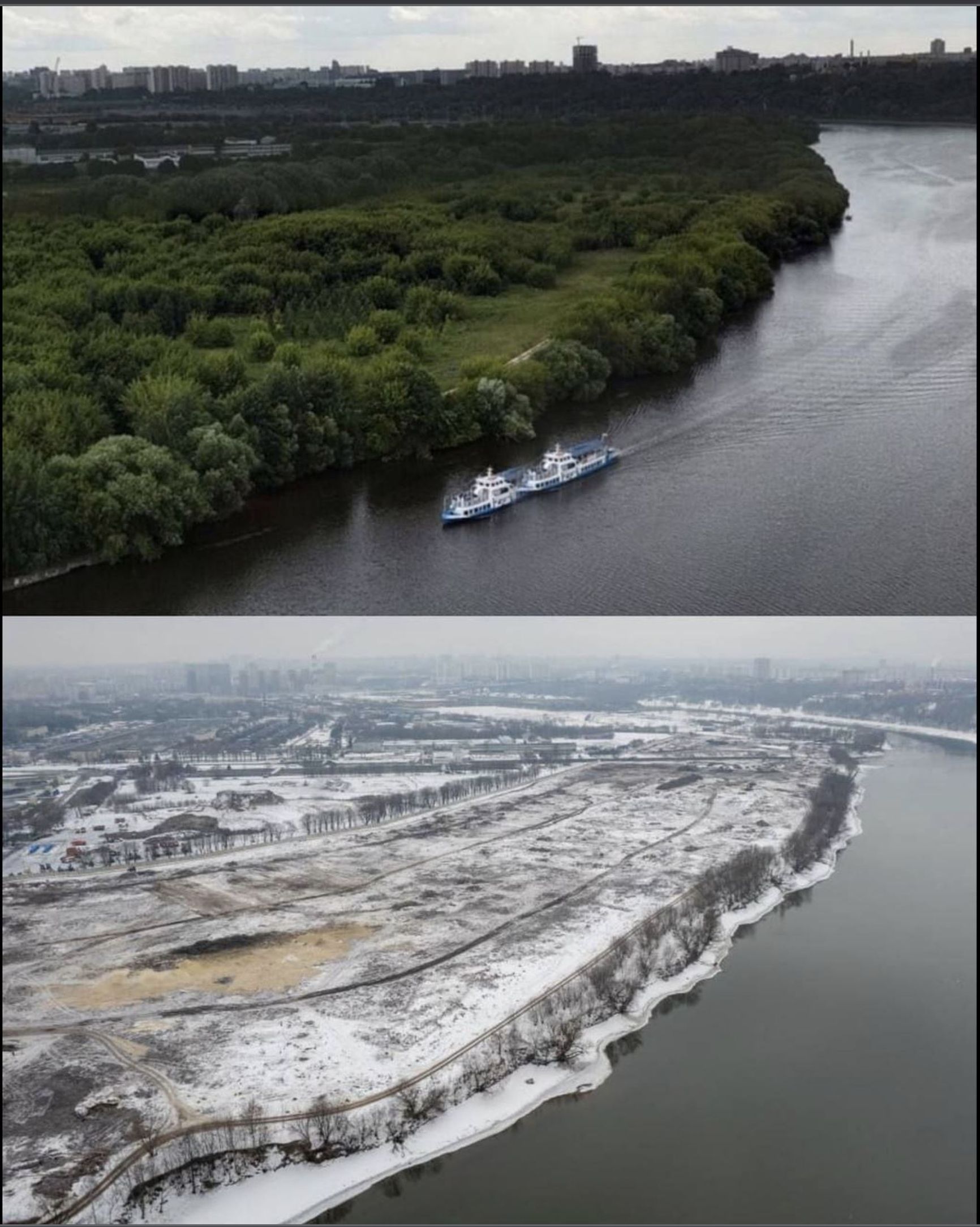
Starting from January 25, the forest was rapidly destroyed, with work going on day and night. The pace was incredible, as it only took a week to cut down the trees and another week to process them into sawdust using shredders. The workers, like the police, confirmed that the purpose of the felling was for defense.
“There will be 10 sites, occupying 55 hectares. At least one of them will house an air defense system,” says Vadim (name changed), an employee of the “SBU Automobile Roads”. He explains that separate teams are working on each site, and that “Avtodor” is only responsible for preparing the sites. According to Vadim, the first site was scheduled to be handed over to the Ministry of Defense by February 21, and the military will take over to complete the process.
According to The Insider's findings, a 5-hectare area in the southern part of the former forest belt will be occupied by the Defense Ministry's site, while the remaining territory, as indicated by the workers' drawings, will be used as “production sites” for companies like Gormost, Moslift, OEK, Mosvodostok, Avtodor SVAO, Moskollector, and others.
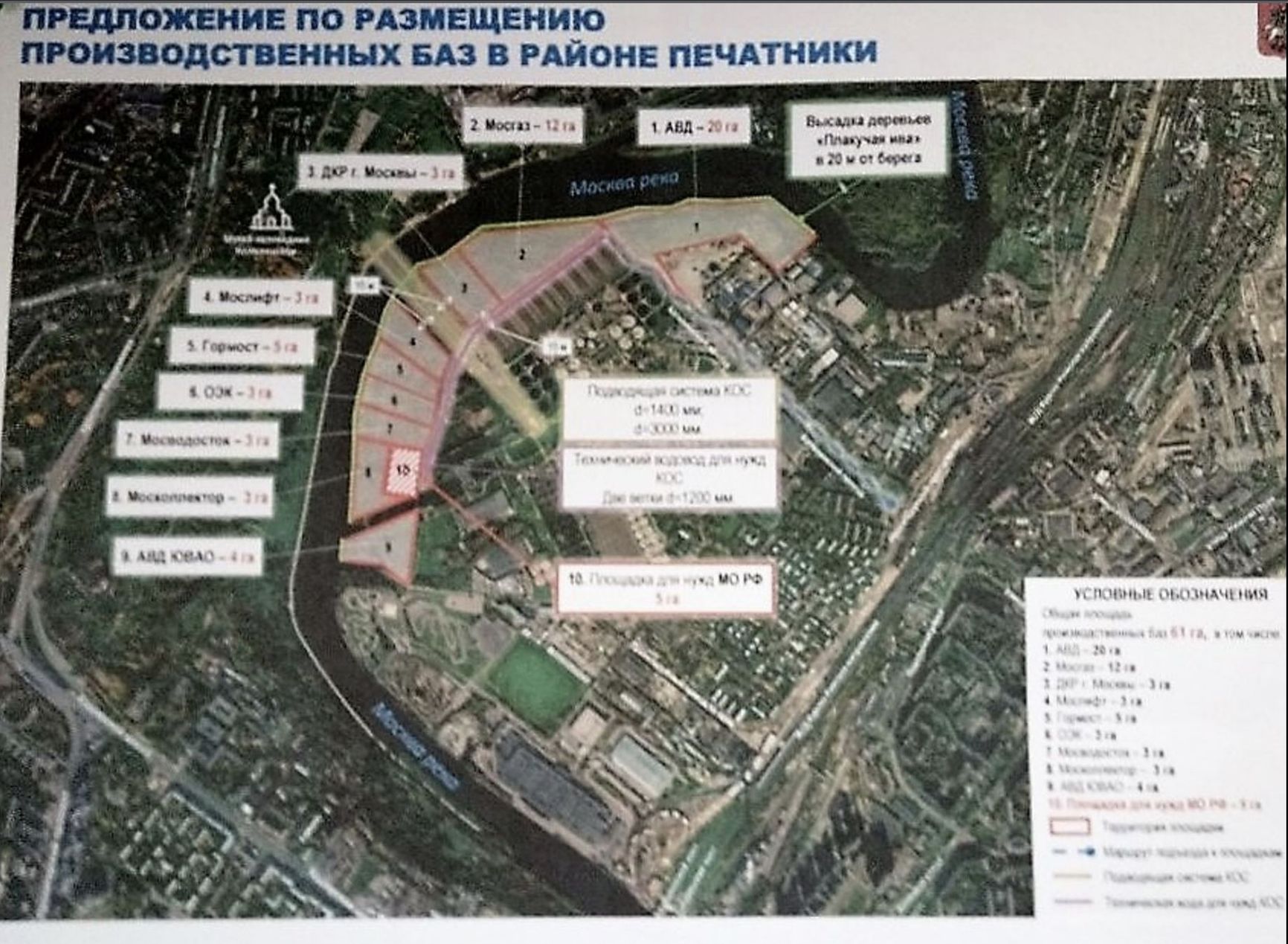
Layout of the sites in Kuryanovo
The larger part of the former forest is being covered in asphalt, signifying that only light buildings or parking lots can be constructed there. Nevertheless, workers indicate that some areas in the central part will also be allotted to the military, though it is not indicated on the plan. An employee of Avtodor stated, “Don't worry, it's only temporary! When the special military operation is complete, everything will be cleared out, and the forest will be replanted!”
Paradoxically, one of the most enigmatic construction sites in Moscow is situated in one of the most prominent locations - directly in front of the Kolomenskoye observation deck, which is equipped with a telescope for tourists. The construction site is largely unsecured, with only a fence and an information board positioned at a single location in the southern part. Some locals remain skeptical about the military installation's existence, speculating that the construction work is taking place to build “a housing complex,” “a factory,” or “a metro station.”
Government agencies and departments have remained silent despite hundreds of letters from concerned Muscovites requesting information about the reason for the extensive deforestation. The residents have not received any official response and their requests are being redirected between departments without any substantive answer. However, Svetlana T. managed to receive some comments after sending a letter describing the violations and requesting an explanation of the works to the mayor's office. The prefecture of the South-East Administrative District replied, stating that “currently the planned activities are in progress, construction equipment is working, and the trees are being removed according to schedule.”
In an attempt to uncover the reason behind the forest destruction, residents of Moscow turned to State Duma deputy Svetlana Razvorotneva via her VKontakte page. However, instead of providing answers, she rebuked the commenters and stated that there was no unique forest in the area. Razvorotneva also hinted that she was aware of the construction project but was unable to discuss its purpose due to “sensitive timing.”
According to The Insider's source in the Investigative Committee, “there is a possibility that there will be a defense facility on this territory.” The source did not specify whether or not S-400s would be located there.
Activists and environmentalists have raised suspicion that the Moscow authorities are using the order of the Ministry of Defense for the preparation of infrastructure for air defense as a cover for their own development plans. According to Andrey Dvornikov, a public activist and local historian from the neighboring Nagatino district, the Moscow authorities may have seized the opportunity to develop the territory for their own purposes. He writes in his “Forgotten Sailors“ blog that “Biryukov <the official in charge of the project> may have taken 1 hectare for the Defense Ministry and added another 99 hectares for his own needs while keeping the order secret to avoid questions.”
The ruthless actions of the builders in flattening the sites have left Moscow residents in shock. According to them, “the situation there is now terrible, as construction waste from various parts of Moscow is being used to level potholes and fill in ravines, with asphalt being poured on top.” The workers have also confirmed this. They have revealed that the leftovers from the demolition of the five-story buildings under the renovation program are being dumped there, along with scraps of wallpaper, wiring, and even large debris.

The construction machinery levels the terrain, filling in a layer of construction debris, including large debris from houses demolished under the renovation program
Kolomenskoye without UNESCO
“You can't even mow the grass here!” Local historian Andrei Dvornikov is outraged, stating that the area covered in asphalt is deemed protected on several counts. Firstly, the territory falls under the Moscow River's water protection zone, which extends 200 meters from the water line; within such zones the Russian Water Code prohibits storage of wastes and explosion hazardous materials, including munitions; construction of warehouses containing combustible materials, vehicle repair stations, and dumping grounds. Secondly, it lies partially within the sanitary protection zone of Kuryanovo wastewater treatment facilities. Thirdly, it is a part of natural complex No. 127, although it is not officially designated as a specially protected natural area. However, the most important reason is its location in protection zone No. 350 of the federal heritage site “Ensemble of the Kolomenskoye Estate, XVI-XVII centuries.” The forest that has been destroyed, along with the Pererva waterworks and the Nikolo-Perervinsky monastery, formed a single scenic complex, constituting the historical landscape surrounding the Kolomenskoye estate, especially its most renowned object, the Church of the Ascension.

The visual surroundings of the heritage site are protected, much like the site itself. The law “On Objects of Cultural Heritage” imposes limitations on economic activity and disallows any construction within the designated protection zones of such sites. This is done to maintain the cultural heritage site's original landscape and historical context. Additionally, Government Decree No. 772-PP of 2012 emphasizes the importance of preserving the “conditions of perception” of the Kolomenskoye Estate.
Approval from the Ministry of Culture of the Russian Federation is necessary for any work to be done in this area. However, requests from Muscovites were first submitted to the Moscow Department of Cultural Heritage, which then forwarded them to the Moscow Department of Environmental Management. The latter then passed on the requests to the Interregional Directorate of Rosprirodnadzor for Moscow and the Kaluga Region, which ultimately sent them to the Committee for State Construction Supervision. The response received from the Committee was that no construction permits had been granted.

moskvatrip.ru
In 1994, the Church of the Ascension was recognized by UNESCO as a World Heritage Site, acknowledging it as a “masterpiece of world architecture” that exemplifies the significance of the connection between human values and the advancement of architectural and technological achievements, monumental art, urban planning, and landscape design. However, there is concern among Muscovites that the monument's UNESCO World Heritage status may be jeopardized due to the extensive modifications made to its surrounding landscape.
There has been no official statement from UNESCO regarding the developments concerning the Kolomenskoye Estate. However, a similar situation occurred in 2012, when the organization's World Heritage Committee contemplated removing the Moscow Kremlin from its list of sites. This occurred after the city authorities initiated construction work without seeking UNESCO's input, which included the restoration of the 14th building, the erection of a technical building in the Taynitsky Garden, and the construction of two pavilions adjacent to the Kutafya Tower.

“This longstanding work has been destroyed overnight, someone has proposed constructing something that will undoubtedly result in our expulsion from UNESCO. Such a move may be perceived as disregarding our national heritage, and we may even be likened to ISIS,” Andrei Dvornikov says.
Installation of military facilities on cultural heritage sites is unacceptable in principle. The Second Protocol of the Hague Convention for the Protection of Cultural Property in the Event of Armed Conflict specifically states: ““The following are offences[...]: using cultural property under enhanced protection or its immediate surroundings in support of military action.”
“Building military structures on this 100-hectare area could have adverse effects on the site, potentially causing harm to our national heritage,” Dvornikov says. “The Church of the Ascension, which is a treasure of ours, must not be exposed to such hazards.”
Destruction of larches in Izmailovsky Park
Another site has emerged in Izmaylovsky Forest Park, seemingly intended for the placement of an air defense system. In early January, a portion of the forest near the entrance of the park, only 500 meters away from Izmaylovskaya metro station, was cleared by municipal workers. As with similar instances, no official information was released.

As per the accounts of Muscovites who witnessed the process, numerous larch trees that were over half a century old were chopped down. The trees were felled near the Cedar Trail tree nursery area, and the process began so abruptly that the staff of the nursery had to hastily rescue hundreds of young seedlings within just a few hours and look for a new area to move them to.
About a hundred workers were brought to the site in Izmailovo. The site was guarded by police and Rosgvardia <Russian Guards>. Within a short time, the clearing site was paved with asphalt. At the time of writing, the military equipment had not yet been delivered.
Air defense on a garbage heap in New Moscow
An air defense system was installed at the Salaryevo landfill in New Moscow, which was, as of 2013, the largest landfill in Europe. Since the 1960s, the area had been utilized for dumping waste, with a total of 15 million tons of waste accumulated by the time the landfill was shut down in 2007. Following this, the site was recultivated, covered with a specialized fabric, and backfilled with soil two years later. In 2017, the Department of Development of New Territories committed to constructing a ski slope on the site of the former landfill.
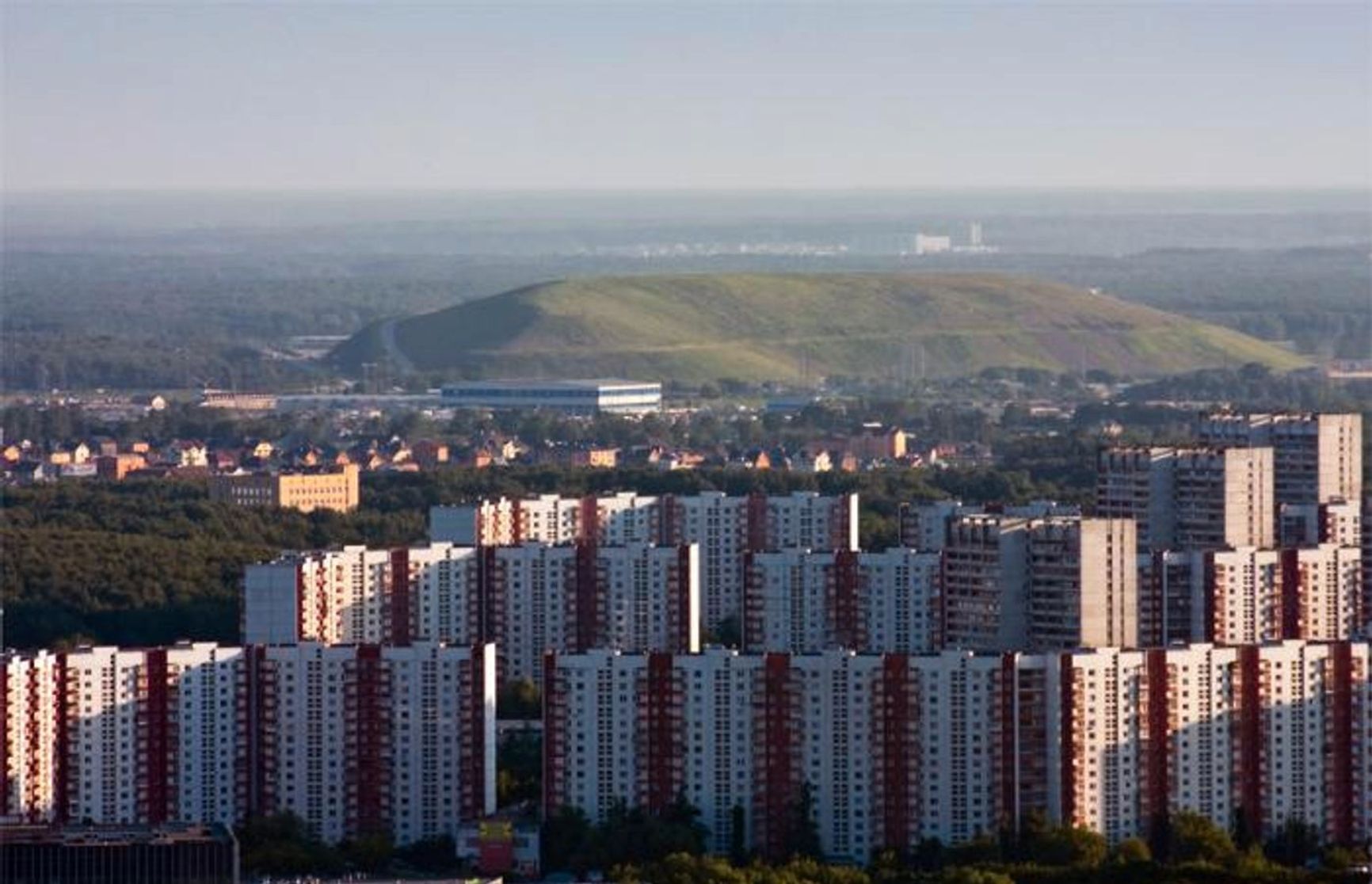
The equipment can be observed from the Salaryevo metro station, as well as by visitors to the Salaris shopping center and residents of the Salaryevo-Park residential complex. The landfill now houses a P-18-2 “Prima” mobile reconnaissance and target designation radar, which operates within the meter range and is built to identify, track, measure coordinates, and determine the origin of airborne objects of various types and classes, according to Rosoboronexport's website.
The presence of a Prima radar system implies that short or medium-range Surface-to-Air Missiles (SAMs), such as the Buk or Tor, are employed in conjunction with it, suggests Ukrainian military specialist Oleksandr Kovalenko. According to Russian military authorities, the Prima is one of the newest domestic innovations capable of detecting stealth aircraft, which are not easily visible to the naked eye. However, the expert says there has been no concrete evidence to support this information.
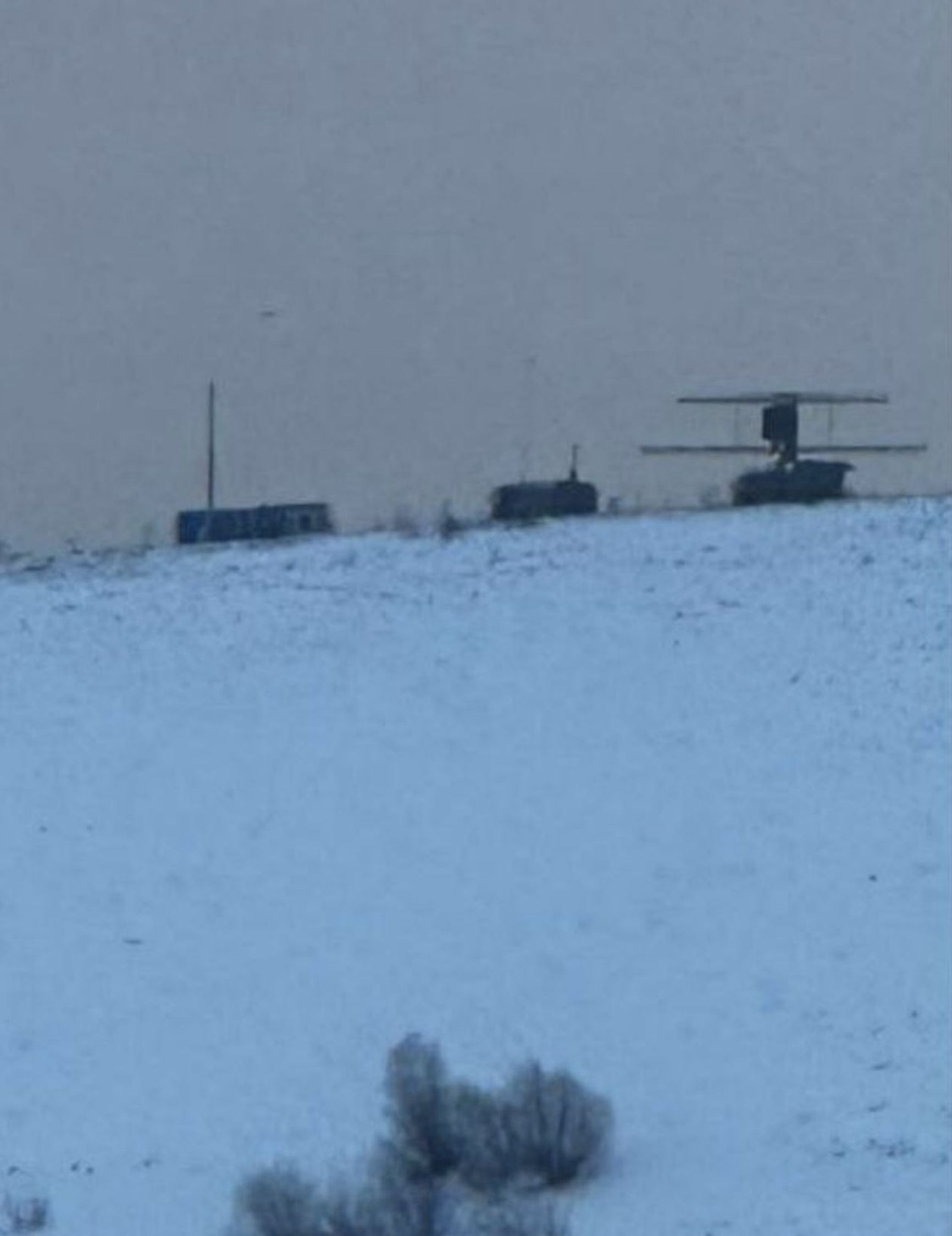
Another expert, who wished to remain anonymous, argues that the Prima is ineffective for small targets such as UAVs:
“The Rosoboronexport website says the Prima operates in the meter radio wave frequency range, signifying that it may lack high-resolution capabilities. To put it simply, the Prima radar may perceive two objects flying 20 meters apart as one.”
Muscovites on the neighborhood Telegram channels are humorously proposing that the heavy equipment might sink into the landfill once the temperature rises, and if any potential target is hit, it could cause a “very dirty bomb” due to the colossal size of the landfill.
Yet, there is minimal discussion on social media platforms since Moscow residents are hesitant to share information about military installations online. They prefer to use euphemisms such as “something that cannot be named,” “this thing,” or “green-painted equipment” instead of directly referring to the air defense system. Group and chat room moderators go as far as removing images of military objects and even messages, in some cases, out of fear of being charged with spreading “fakes.”
Pantsir-S1 in central Moscow
As S-400 SAMs surfaced in Moscow's residential areas, multiple Pantsir-S1 SAMs were installed in the city center. These medium-range systems are capable of safeguarding “small military, including mobile, administrative, and industrial facilities and areas against aerial threats such as aircraft, helicopters, cruise missiles, and precision-guided weaponry.”
A Pantsir was observed on the Ministry of Defense building on Frunzenskaya Embankment. It was first noticed on December 25, and multiple Telegram channels posted images of the complex on January 19. The author of the Military Informant channel pointed out that such measures of deploying air defense systems within the city's periphery “would not be carried out without a valid reason,” presumably indicating the military's concerns regarding a prospective attack.
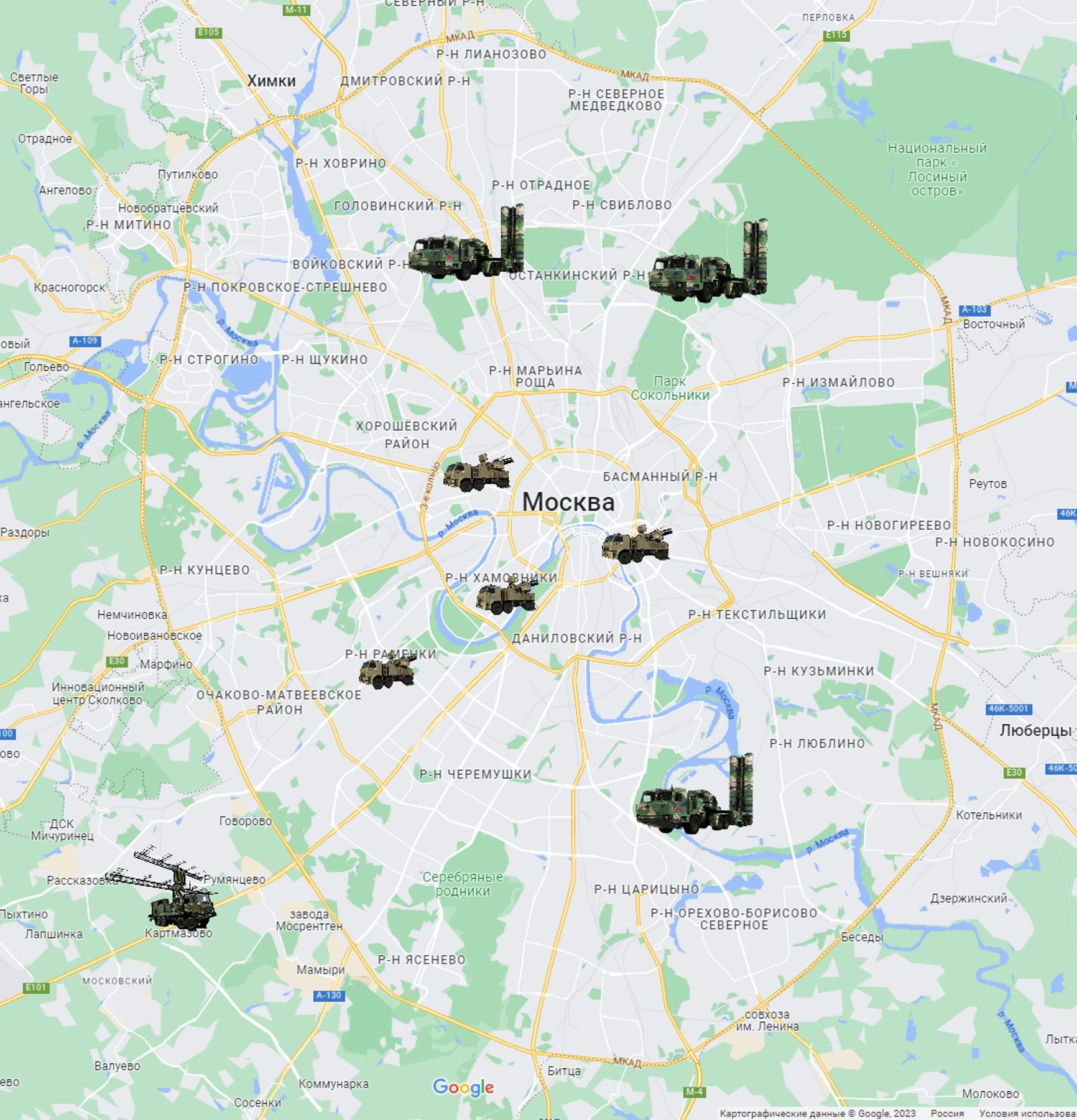
Also in January, Muscovites witnessed a SAM system resembling the Pantsir-S1 being hoisted onto the roof of a building at 8 Teterinsky Lane, close to Taganskaya metro station. Two additional complexes were spotted at 38A Petrovka, in proximity to Moscow's Main Directorate of Internal Affairs, and on top of the printing shop building near the 1905 Street metro station. The day before the “Glory to the Defenders of the Fatherland” rally-concert in Luzhniki, a Pantsir-S1 was spotted on Sparrow Hills.
There is not enough air defense systems to protect all of Moscow
Despite Russia's criticism of the Ukrainian military's deployment of air defense systems near residential areas, which they claim results in “attacks on civilian objects” (Russia's Permanent Representative to the UN, Vasily Nebenzya, has brought up this issue several times), Russian Ministry of Defense has yet to comment on the matter of air defense system deployment in Moscow.
Deploying air defense systems in urban areas is not advisable unless the country is under martial law, as it poses unjustifiable risks during times of peace, Alexander Kovalenko told The Insider:
“Placing surface-to-air missile systems, or missile and gun systems within the city limits, particularly in the city center, without Russia officially declaring martial law, violates safety regulations as it could result in uncontrolled launches and other emergencies. These systems pose a danger to the population and should be situated outside the city limits.”
However, if martial law is declared in the country, the installation of these systems is permitted. Different norms apply in this case, and air defense systems can be positioned within the city limits to enhance the effectiveness of air defense and provide protection from actual air threats.
Kovalenko believes that the Russian military prioritizes protecting the center when establishing air defense echelons. However, he also observes that the southwestern direction, where the Kremlin claims the potential enemy is located, remains unprotected.
“An object of small size flying from the south may go undetected by the S-400 surface-to-air missile system, making it vulnerable to destruction. At the same time, the Pantsir S-1, which is meant to provide coverage for the S-400, is too far away to offer any form of protection.”
It is possible that more Pantsir systems will be added in the future. However, the peculiar arrangement of echelons may be due to a scarcity of SAMs in Russia. Kovalenko says that a combined total of 132 Tor-M2 SAMs and 116 Pantsir-S1 SAMs have been manufactured. During the conflict in Ukraine, Moscow suffered the loss of 14 Tor and 12 Pantsir systems. The AFU General Staff claims that the number of losses is even higher, at 30 and 33 units, respectively.
“When it comes to protecting Moscow, the military is faced with a difficult decision. They must choose between establishing an outer perimeter of defense for long-range complexes, which could compromise the safety of the center, or concentrating on protecting the center of the capital, potentially using the S-400 complexes as a form of human shield,” Kovalenko says.